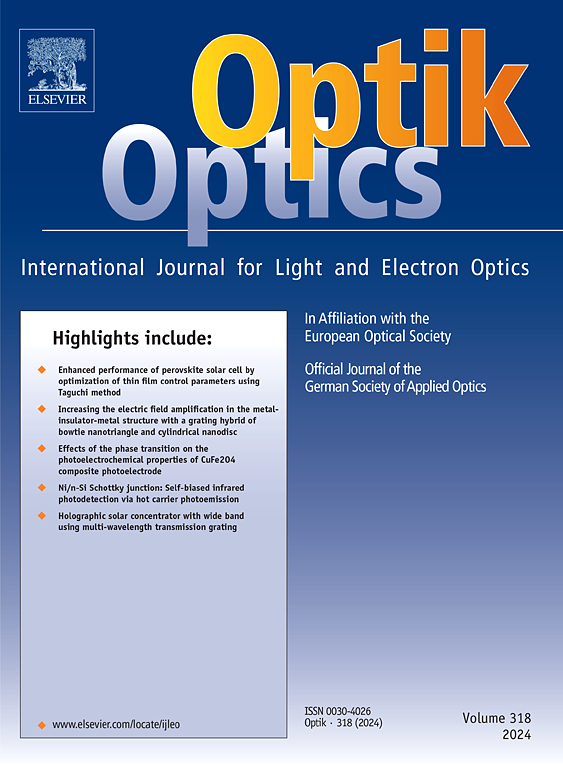铝合金的微波辅助激光诱导击穿光谱改进定量
IF 3.1
3区 物理与天体物理
Q2 Engineering
引用次数: 0
摘要
本研究采用微波辅助激光诱导击穿光谱(MW-LIBS)研究了发射线强度、等离子体参数和分析测量的灵敏度和再现性。标准铝合金(中国厦门一辰科技有限公司)因其广泛的应用和优异的物理力学性能而被采用。这些合金的等离子体是用Nd: YAG激光基频(1064 nm)产生的。在激光能量(40-260 mJ)和微波功率(400、800和1200 W)下记录等离子体发射。MW装置由风冷的2.45 GHz微波源(磁控管)、WR340波导、3根阻抗调谐器和波导同轴适配器组成。一种一米长的同轴电缆,一端削尖,用作近场天线。实验参数,如激光能量,微波功率,探测器门延迟,优化灵敏度和重复性。优化后的激光能量为140 mJ,微波峰值功率为1200 W,与传统LIBS相比,信号增强提高了6倍,信噪比(SNR)提高了5倍,检出限(LOD)降低了7倍。以相对标准偏差(RSD)测量的发射线强度的重复性,Mg、Si和Cu的发射线分别从36 %显著提高到6 %、46-18 %和27-13 %。发射线强度重复性的提高提高了基于校准曲线的预测浓度测量的准确性,Mg的百分比偏差为18-3 %,Si的百分比偏差为35-11 %。本文章由计算机程序翻译,如有差异,请以英文原文为准。
Microwave-assisted laser-induced breakdown spectroscopy on aluminum alloy for improved quantitation
This study employed microwave-assisted laser-induced breakdown spectroscopy (MW-LIBS) to investigate the sensitivity and reproducibility of emission line intensity, plasma parameters, and analytical measurements. Standard Al-alloys (Xiamen Yichen Technology Co., China) were used due to its wide applications and excellent physical and mechanical properties. The plasmas of these alloys were produced using a fundamental harmonic (1064 nm) of Nd: YAG laser. The plasma emissions were recorded at laser energies (40–260 mJ) and microwave power 400, 800, and 1200 W. The MW setup consists of air-cooled 2.45 GHz microwave source (magnetron), a WR340 waveguide, a 3-stub impedance tuner, and a waveguide-to-coaxial adaptor. A one-meter coaxial cable with a sharpened end served as a near-field antenna. The experimental parameters, such as laser energy, microwave power, and detector gate delay, were optimized for sensitivity and repeatability. At an optimized laser energy of 140 mJ and a microwave peak power of 1200 W, signal enhancement was observed to increase six-fold, the signal-to-noise ratio (SNR) improved five-fold, and the limit of detection (LOD) decreased seven-fold compared to conventional LIBS. The repeatability in emission line intensity, measured in terms of relative standard deviation (RSD), was significantly improved from 36 % to 6 %, 46–18 %, and 27–13 % for Mg, Si, and Cu emission lines, respectively. The improvement in repeatability of emission line intensities led to improved accuracy in predicted concentration measurements based on calibration curves, with percentage deviations of 18–3 % for Mg and 35–11 % for Si.
求助全文
通过发布文献求助,成功后即可免费获取论文全文。
去求助
来源期刊

Optik
物理-光学
CiteScore
6.90
自引率
12.90%
发文量
1471
审稿时长
46 days
期刊介绍:
Optik publishes articles on all subjects related to light and electron optics and offers a survey on the state of research and technical development within the following fields:
Optics:
-Optics design, geometrical and beam optics, wave optics-
Optical and micro-optical components, diffractive optics, devices and systems-
Photoelectric and optoelectronic devices-
Optical properties of materials, nonlinear optics, wave propagation and transmission in homogeneous and inhomogeneous materials-
Information optics, image formation and processing, holographic techniques, microscopes and spectrometer techniques, and image analysis-
Optical testing and measuring techniques-
Optical communication and computing-
Physiological optics-
As well as other related topics.
 求助内容:
求助内容: 应助结果提醒方式:
应助结果提醒方式:


